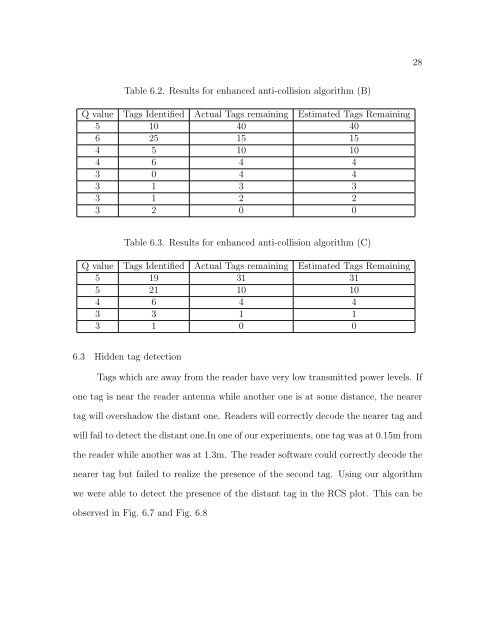utilizing physical layer information to improve rfid tag
utilizing physical layer information to improve rfid tag
utilizing physical layer information to improve rfid tag
Create successful ePaper yourself
Turn your PDF publications into a flip-book with our unique Google optimized e-Paper software.
Table 6.2. Results for enhanced anti-collision algorithm (B)<br />
Q value Tags Identified Actual Tags remaining Estimated Tags Remaining<br />
5 10 40 40<br />
6 25 15 15<br />
4 5 10 10<br />
4 6 4 4<br />
3 0 4 4<br />
3 1 3 3<br />
3 1 2 2<br />
3 2 0 0<br />
Table 6.3. Results for enhanced anti-collision algorithm (C)<br />
Q value Tags Identified Actual Tags remaining Estimated Tags Remaining<br />
5 19 31 31<br />
5 21 10 10<br />
4 6 4 4<br />
3 3 1 1<br />
3 1 0 0<br />
6.3 Hidden <strong>tag</strong> detection<br />
Tags which are away from the reader have very low transmitted power levels. If<br />
one <strong>tag</strong> is near the reader antenna while another one is at some distance, the nearer<br />
<strong>tag</strong> will overshadow the distant one. Readers will correctly decode the nearer <strong>tag</strong> and<br />
will fail <strong>to</strong> detect the distant one.In one of our experiments, one <strong>tag</strong> was at 0.15m from<br />
the reader while another was at 1.3m. The reader software could correctly decode the<br />
nearer <strong>tag</strong> but failed <strong>to</strong> realize the presence of the second <strong>tag</strong>. Using our algorithm<br />
we were able <strong>to</strong> detect the presence of the distant <strong>tag</strong> in the RCS plot. This can be<br />
observed in Fig. 6.7 and Fig. 6.8<br />
28
















